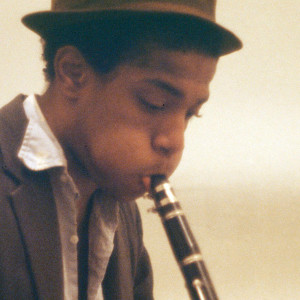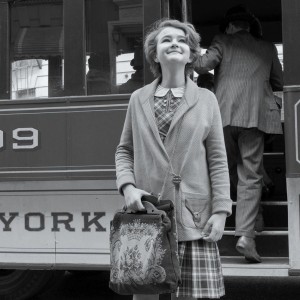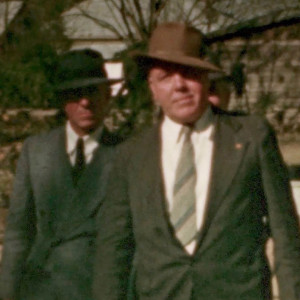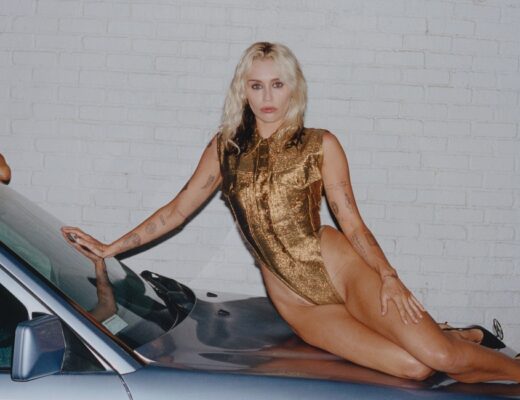Our fifth and final dispatch from this year’s New York Film Festival (here’s one, two, three, and four) includes a couple of films about various forms of appreciation (or lack thereof) for the arts — Ruben Östlund’s Palme d’Or-winning art world comedy The Square and Todd Haynes’s YA adaptation Wonderstruck — as well as Greta Gerwig’s sharp and funny coming-of-age film Lady Bird. There are also three features here from outside of NYFF’s main slate: Sara Driver’s Boom for Real: The Late Teenage Years of Jean-Michel Basquiat, Travis Wilkinson’s Did You Wonder Who Fired the Gun? (both Spotlight on Documentary selections), and Chinese artist Xu Bing’s experimental Dragonfly Eyes (which showed as part of NYFF’s Projections side-bar).
 At the start of Ruben Östlund‘s The Square, arrogant Stockholm museum curator Christian (Claes Bang) is preparing to unveil a new installation pinned on a large neon square that the artist has placed in the concrete outside the museum. The Square “is a sanctuary of trust and caring. Within it we all share equal rights and obligations.” Three guesses as to what this movie is about. For the most part, Christian is a hypocritical, arrogant ass; he mistreats women and his subordinates, is immediately suspicious of the poor or the non-white, and is generally dismissive of anyone who can’t give him something he wants. He’s not the only one either: Anne (Elizabeth Moss), a journalist whom he casually sleeps with and then discards, and another artist, Julian (Dominic West), are both just as self-serving. What we see of the museum’s installations are an often hilarious but very on-the-nose parody of ineffectual conceptual art, like a bunch of piles of dirt sitting on the floor in an otherwise empty room that you aren’t allowed to take pictures in. Even the patrons are more interested in a buffet at an event than the work being feted or any of its ideas.
At the start of Ruben Östlund‘s The Square, arrogant Stockholm museum curator Christian (Claes Bang) is preparing to unveil a new installation pinned on a large neon square that the artist has placed in the concrete outside the museum. The Square “is a sanctuary of trust and caring. Within it we all share equal rights and obligations.” Three guesses as to what this movie is about. For the most part, Christian is a hypocritical, arrogant ass; he mistreats women and his subordinates, is immediately suspicious of the poor or the non-white, and is generally dismissive of anyone who can’t give him something he wants. He’s not the only one either: Anne (Elizabeth Moss), a journalist whom he casually sleeps with and then discards, and another artist, Julian (Dominic West), are both just as self-serving. What we see of the museum’s installations are an often hilarious but very on-the-nose parody of ineffectual conceptual art, like a bunch of piles of dirt sitting on the floor in an otherwise empty room that you aren’t allowed to take pictures in. Even the patrons are more interested in a buffet at an event than the work being feted or any of its ideas.
And so what you’ve got is a heavy-handed, sort of clumsy commentary on inclusive spaces, unexamined privilege, and performative allyship that’s about people who make and promote heavy-handed, sort of clumsy art about inclusive spaces, unexamined privilege, and performative allyship — rather than confronting their own hypocrisies. And that’s fine enough: The Square is often very funny, it gets a lot of mileage out of its alleged timeliness, and, despite lacking almost any ambiguity whatsoever, it’s quite sharp with its barbs. A centerpiece scene, in which an actor, Oleg (Terry Notary), acts like a very aggressive ape and antagonizes the crowd at a fundraising gala, escalates from simple discomfort to sheer terror just as you’ve decided you’ve got the point of the scene — a gambit the film pulls off more than once. The Square feels spontaneous even when it’s most absurdly schematic, and during the many scenes in which characters explain it all to you. Alex Engquist
Nearly every film Todd Haynes has made is a period piece, and throughout his career he has worked with production and costume designers who have helped evoke the stylistic details of the past in a way that seems more vivid than historical record, depicting eras as lucid memories, rather than as realism. Wonderstruck, which has been adapted by Brian Selznick from his own novel, takes this kind of personal remembrance as its subject, placing it in the context of curation, which it suggests is a science born of loss and alienation, a desperate need to connect with one’s past. In 1927, a young deaf girl named Rose (Millicent Simmonds) runs away from her overbearing father in New Jersey to find Lillian Mayhew (Julianne Moore), a silent film star she obsesses over. In 1977, a boy named Ben (Oakes Fegley), who is mourning the recent death of his mother, loses his hearing in a freak accident and hops a bus in search of his long-lost father. Both children end up in New York, drawn to the American Museum of Natural History and its dioramas — which are vital to Rose’s understanding of her future, and to Ben’s understanding of his past.
Paralleling these two stories, and their respective periods, gives Haynes much to play with. Cinematographer Edward Lachman shoots the 1927 scenes in black and white, mimicking the look—if not always the grammar—of silent film. (In one scene, Rose goes to the theater to see her idol’s latest work, and Moore channels Lillian Gish in massive, Sjostrom-esque gusts of wind). In contrast, New York circa 1977 has the saturated, yellowish look of New Hollywood landmarks like The French Connection and The Conversation. The hearing impairment that Rose and Ben share is also key to Wonderstruck’s visual palette, so closely attuned are the film’s images to tangential sights that catch the eye. When Ben crosses the street outside Port Authority, after arriving in New York, Haynes’s camera feasts on a crowd of extras clad in garishly-colored halter tops and wide lapels. One wonders what kind of queerer, funkier film Wonderstruck could have been were it not so bound to Selznick’s book. (An early scene involving Ben mistaking his cousin for his dead mother and spacing out to David Bowie on vinyl hints at a preteen Velvet Goldmine that never quite manifests.) But the climax here, played-out with model figurines (a la Haynes’s singular Superstar: The Karen Carpenter Story), makes it clear that Haynes hasn’t so much lost touch with his roots in Wonderstruck as he has consciously planted them in a different place, recasting a fascination with the past as an attempt to fill gaps in personal and collective memory. Matt Lynch

Ronan and Metcalf are both superb here; their prickly exchanges represent some of the finest onscreen mother-daughter duels since Anna Paquin and J. Smith-Cameron faced off in Margaret. Marion works as a nurse and is often described as having a “big heart,” generous with co-workers and patients alike, but she seems to reserve a level of passive aggression for her daughter that Lady Bird interprets as outright contempt (as she says to a friend, point-blank, “she hates me”). Marion’s devotion to her daughter is just as deeply felt as her frustration: When Lady Bird and Marion comb discount racks for a prom dress, their bickering only subsides at the moment they agree on the perfect one, which is quickly followed by a cut to Marion working alone at her sewing machine, altering the dress while Lady Bird sleeps. Throughout Lady Bird, Gerwig foregrounds the effect that class-based economic anxiety has on relationships and sense of self, an idea rarely even acknowledged in mainstream American film. Tensions within the McPherson household are exacerbated by small spaces like a narrow kitchen and shared bathroom, while Lady Bird passes a much larger house off as her own to impress a wealthy classmate. There’s also a lovely, melancholy montage of mother and daughter touring open houses they could never afford, losing themselves and their conflicts in shared fantasy for an afternoon. That Gerwig manages to evoke so much truth—about mothers and daughters, the Stockholm Syndrome involved in feeling trapped in the place one grew up in, the self-consciousness inherent in an adolescent’s search for identity—within the familiar confines of Lady Bird‘s funny, sweet coming-of-age story is something of a miracle. AE
The name of Dotham, Alabama comes from Genesis and 2 Kings: The Dothan of the Bible is where Elisha sees his vision of flaming chariots, conjured as a miracle. The town has seen no miracles. Instead, its day-in and day-out history of sin has become a banal staple amongst the townspeople, and dissent must be voiced in hushed tones. It’s in Dothan that filmmaker Travis Wilkerson’s great-grandfather, S. E. Branch, killed a black man, Bill Spann, and got away with it. Wilkerson’s Did You Wonder Who Fired the Gun?, the director’s second feature — narrated in his noir-influenced radio-play format — follows this Biblical path: the sins of the father are visited by the son. Wilkerson himself must dive into his family history to figure out the truth. Outside the title, however, Wilkerson does no wondering: he knows that Branch killed Spann, and the recent white-on-black killings have brought a level of shame that Wilkerson can no longer ignore. These killings — and the Black Lives Matters response to them — act as a current for the filmmaker to push forward in, as each part of his journey is prefaced with Janelle Monae and Wondaland’s radical rally cry (“Hell You Talmbout”). This journey includes footage of dilapidated Alabama towns, cleverly rearranged footage of S. E. Branch, and still photos gathered from whoever still has memories. As Wilkerson’s detective routine gives him a few more clues, citizens of Dothan and neighboring towns become more open about the event, where Spann may be buried, and how to find out more.
However, Wilkerson’s effort also attracts the attention of his sister Jean, an ex-hippie who’s recently joined the Southern nationalist League of the South, and who’s not terribly keen on speaking ill of her killer relative — nor is she terribly keen on her brother finding anything out. And although Wilkerson bluntly states that he doesn’t want to give the League a platform, Neo-Confederate imagery persists throughout his film; in fact, a long section overlays League leader Michael Hill’s white supremacist agenda (shot like a child’s YouTube rant: a ersatz-professional intro graphic emblazons the “Southern News Network,” but it’s followed by a low-quality headshot of Hill rambling about nationalism) over Wilkerson’s own sister’s presence at a League march. It’s a shot that reveals Did You Wonder Who Fired the Gun?’s real ambition: not justice, not answers, but an unveiling of the emotional division between current Southern whites. Pride, and the threat of taking away that pride, has determined much politics and history in the white South. Wilkerson shows here that the opposite of pride is not weak guilt, but a stronger sense of community. Zach Lewis

The most glaring issue, however, is the strange absence of Basquiat himself at the center of the film. Though talked about in most of the interviews (which include people who knew him well; close collaborators; friends; roommates; and ex-lovers) and seen in footage and photos from the era, his own voice remains completely unheard, and as such, Boom for Real never feels like it probes deeper than the surface. Of course, Basquiat contributed to this obfuscation of self with his SAMO graffiti tags and prankish persona, but the extent to which the film mentions him while so rarely allowing him a voice is perhaps unintentionally revealing. “I was in the presence of the most vivid representation of an era,” one talking head reverently recalls toward the end of the film. With a few exceptions (such as hip-hop icon Fab Five Freddy), the people interviewed for Driver’s film did not achieve anywhere near the level of fame and influence as Basquiat and now work as writers and curators anthologizing the scene they once inhabited, so the whole enterprise has the feeling of a weirdly desperate grab at cool-by-association, a feature-length name-drop. Driver’s longtime partner Jim Jarmusch pops up to encapsulate Basquiat’s appeal, describing him as “a true investigator of visual ideas and language.” But there’s depressingly little investigation in Boom for Real, which seems content to reiterate ideas that have already been spoken, and in language that’s familiar. AE

As a collage representation of a suppressed reality — the recorded record, unbroadcasted, of moral decay in a too rapidly modernizing China — Dragonfly Eyes is as frequently disturbing and revealing as Huang Weikai’s 2009 found footage film Disorder. But Xu has also built a narrative into this document: A linearly told, broadly dramatized love story about two marginalized people pushed further and further apart by the mounting consequences of defending their own dignity. It’s this element of the film that tends to scan less as a targeted cultural commentary than an expression of pure misanthropy. It also narrows the implications of Xu’s most disturbing images, suggesting a metaphorical context that unequivocally cheapens them. Sam C. Mac









